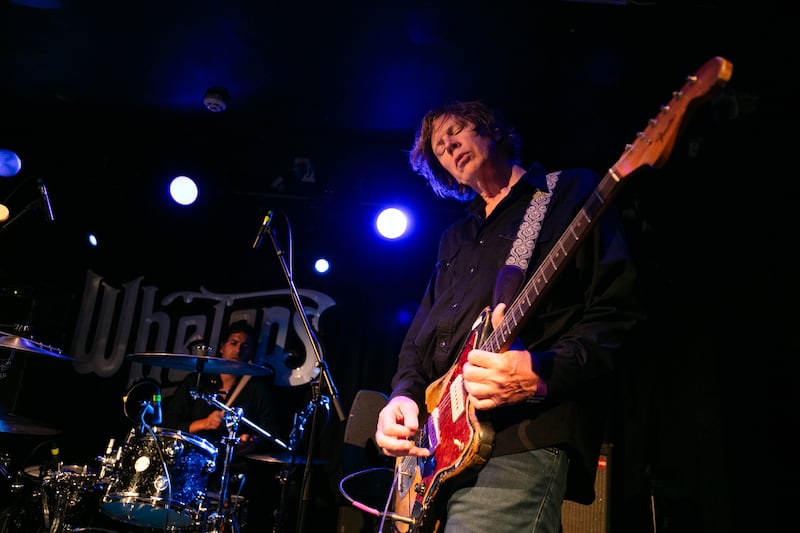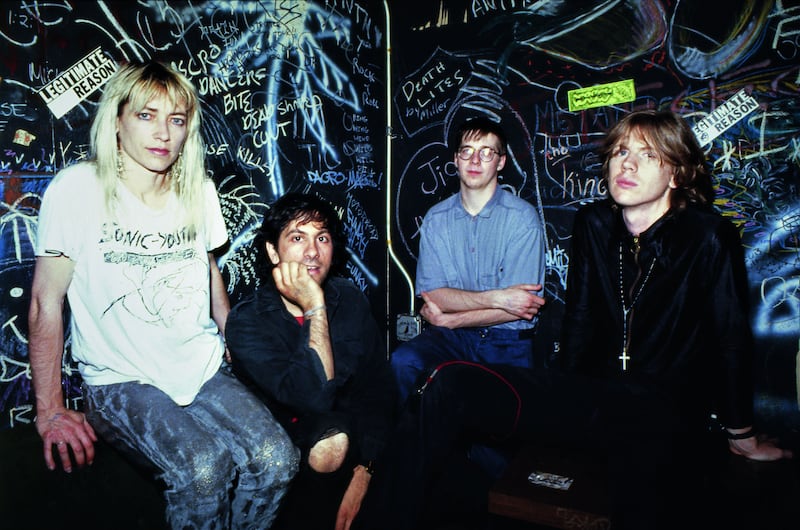This summer, on the eve of his 65th birthday, Thurston Moore, his band and a few friends, including Kevin Shields, Colm Ó Cíosóig and Debbie Googe of My Bloody Valentine, crammed into a dressingroom at Whelan’s, the Dublin music venue, for an impromptu party after a blistering live set. Before the show, as he hunched over his guitar, to tune it – roadies were conspicuous by their absence – he found a few moments to talk about Sonic Life, the memoir he published a few months later.
“I was reading an interview with Glen Matlock the other day about touring with Blondie,” Moore, who is tall and gregarious, said, referring to the former Sex Pistol. “He said the best thing about it was not having to do all the donkey work. I had the luxury of a crew with Sonic Youth for several years, where you’d just show up and go onstage, but I never considered the process of loading up the van and getting to the gig in any sort of derisory way. I just thought it was part of the glory of rock’n’roll. Not everyone has the privilege of being in the Foo Fighters. I don’t feel like I necessitate that kind of comfort.”
Sonic Life is a testament to the power of music and art. It opens with his brother, Gene, bounding into their childhood home in Florida brandishing a copy of The Kingsmen’s single Louie Louie as if he had found “a gift of gold dropped from a psychedelic UFO”. Moore describes becoming besotted with The Stooges’ first album, which would become his “best friend” and inspire him to acquire his first ever “noise machine” at the age of 16.

Moore went on to have a hand in creating many magical UFOs through Sonic Youth, the art-rockers who helped define alternative music and its culture. An early description of Sonic Youth was as “dentist drill drone music”. “There is no way in hell I can recommend this band, or even tolerate being in the same room with them,” one early reviewer wrote. But during a remarkable imperial phase between 1985 and 1988, the band released Bad Moon Rising, Evol, Sister and Daydream Nation – which Pitchfork ranks as the best album of the 1980s and the Library of Congress added to the United States’s National Recording Registry.
From Baby Reindeer and The Traitors to Bodkin and The 2 Johnnies Late Night Lock In: The best and worst television of 2024
100 Years of Solitude review: A woozy, feverish watch to be savoured in bite-sized portions
How your mini travel shampoo is costing your pocket and the planet - here’s an alternative
Moore still exudes the infectious zeal of a music fan who has spent a lifetime steeped in underground culture. His depiction of New York in Sonic Life is of a radically different place from the gentrified megalopolis of today. Back in the late 1970s – before, he says, money killed the city he loved – the aspiring musician soaked up its vibrant counterculture, regularly encountering cult figures such as Joey Ramone, Johnny Thunders and Lydia Lunch. Moore later collaborated with Lunch; he can recall one live performance at which he could clearly hear Joe Strummer of The Clash bellowing his disapproval.
In Sonic Life, Moore writes about encountering Nirvana live for the first time at Maxwell’s, a storied venue in Hoboken, New Jersey. He and Sonic Youth forged a close bond with Kurt Cobain and his bandmates; in the early 1990s they launched a European tour together at Sir Henry’s in Cork and the Top Hat in Dún Laoghaire. The shows became Irish indie kids’ equivalent of being in the GPO in 1916. Footage from this short but infamous Irish tour featured in Dave Markey’s celebrated documentary 1991: The Year Punk Broke.

If 1991 was the year punk broke, then 1992 was the year Sonic Youth crossed over. Some joked that their name wasn’t particularly apt any more – Moore had turned 40 by the time this happened – but, as it turned out, they were reckoning without all the big names who would continue to tour well into their senior years. “People say if Sonic Youth got back together we could make millions,” Moore says. “Even if it was exactly the same set of members, it would be a completely different story if we changed the name, because it’s all about the name.”
When Moore spoke to The Irish Times in 2017, he said he could understand why fans were upset about the end of his marriage to Kim Gordon, Sonic Youth’s bassist, who had published her own book, the candid Girl in a Band, in 2015. Moore says that Sonic Life is not his response to Gordon’s version of events. “I realise that is going to be a real question, but for me everyone is free to write whatever they want,” he says. “It didn’t define how I approached writing Sonic Life at all. I really wanted to write about the life of a band rather than the power struggle of a married couple in a band.”
[ From the archive: Kim Gordon – The bands, the blues, and other sonic truthsOpens in new window ]
Moore, who is now married to Eva Prinz and living in London, also says, “I didn’t want to get into a Morrissey thing of settling scores. I didn’t want to haul people into any situation that was personal. The reality is that music is such a microcommunity. I was fascinated by Morrissey’s book, because I knew the people who he was talking about, but I certainly didn’t want to get into the nitty-gritty of everything that happened, because I think it would be very unfair to everyone. I wanted the least amount of drama.”
Moore has long been passionate about writing. He has contributed to several books, published a collection of lyrics and moonlighted as a fanzine writer and journalist, and he teaches a summer course at the wonderfully named Jack Kerouac school of disembodied poetics, which Allen Ginsberg and Anne Waldman founded in 1974 at Naropa University, in Colorado. “Music memoirs have become a high-profile industry,” Moore says. “People who were there in the 1980s and 1990s want to viscerally return to that milieu. Then you’ve got younger readers who want to know about what happened. Hopefully this book speaks to both.”
Sonic Life is published by Faber & Faber










